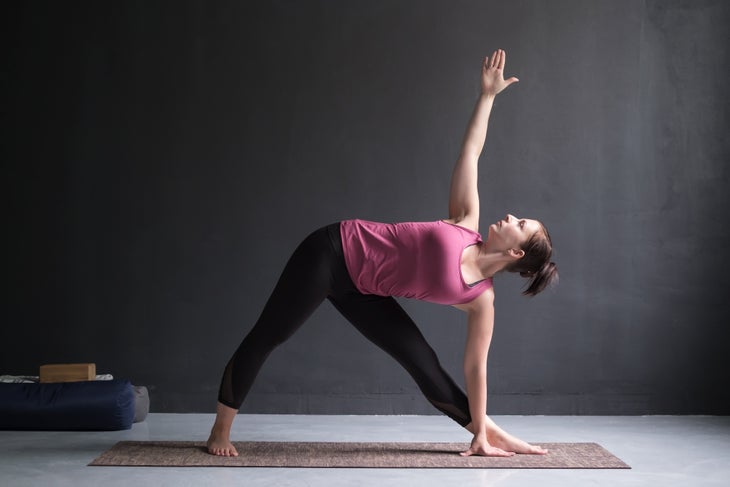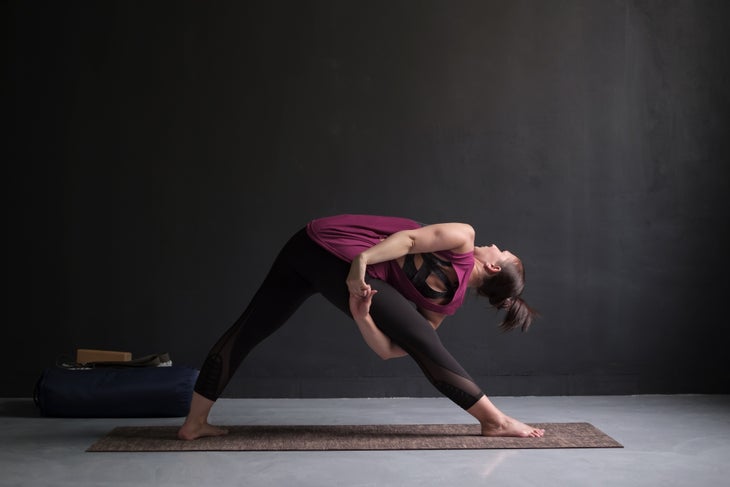Heading out the door? Read this article on the new Outside+ app available now on iOS devices for members! Download the app.
You know the feeling: A leg stretch softens your tight shoulders, a hip-opener relieves your low-back pain. This happens by nature’s design: We each have a body-wide collagenous web, commonly called “fascia,” and when something happens to one part of the web we can feel its effects elsewhere.

“Is a Forward Bend a hamstring stretch? Well, yeah. But it’s so much more,” explains Tom Myers, author of Anatomy Trains and co-author of Fascial Release for Structural Balance. “If you are not considering the fascia in your yoga, you are not seeing the picture for what it is.”
Why Fascia Matters
Cells are our building blocks, and something has got to hold them in a recognizable shape, explains Myers. And that’s the role of fascia. “If you were going to hold 70 trillion cells together, you’re either going to glue them together or you’re going to weave them together. Evolution decided to do both,” he says.
Fascia surrounds structures in your body, including muscles, organs, and bones. It also occupies the space between your cells, interstitial space. Fascia both integrates and separates your body’s structures and systems. This way of thinking about the body moves away from identifying isolated parts. Rather, you work as a whole,” says Myers. “The body is not assembled out of parts like your Ford F-150 or your Dell computer. It is grown from a seed. The seed you’re grown from is a fertilized ovum,” Myers says. “You have never had a nervous system separate from your fascial system, separate from your muscles, separate from your epithelia, separate from your hormones.”
Fascial Elements and Yoga
Movement, including yoga asana, keeps fascia healthy, by keeping it active, hydrated, and resilient. Yoga affects four key elements of fascia:
- Water. Fascia is mostly water. When you stretch or contract muscles, or hold a yoga pose, water squeezes from your fascia. When you stop the movement or exit a stretch, your tissue rehydrates—with a boost: Scientific evidence shows that fascia soaks up more water than it lost when you squeezed it out through movement. “The water moves, the water changes position, and the water carrying all kinds of chemicals in and out of your tissue, including neuropeptides, hormones, new proteins, histamines.” Yoga is especially good at facilitating this renewal because its postures move your body systematically through full ranges of motion.
- Hyaluronan. Hyaluronan is spongy and soaks up water. When well-hydrated, it has a gel-like texture similar to egg whites. “There’s almost zero friction inside your joints because of the really good lubricative properties of this hyaluronan when it’s in its wet stage,” Myers says. But when hyaluronan is less hydrated, it’s sticky. When you stop moving, or through natural aging, the fascia is less lubricated and joints start rubbing on each other, moving then toward arthritis. . The actual chemistry inside the joints moves it toward an arthritic state, a degenerated state. Overuse can be problematic too: inflammation from too much friction can cut up hyaluronan chains, making it harder for the tissue to stick together and keep water at bay. “Water comes rushing in, and we call that swelling,” Myers says.
- Glycoaminoglycans. Glycoaminoglycans capture moisture. They unfurl like ferns when near water, drawing water molecules along their edges. Inactivity keeps them curled in on themselves. “The movements that you’re doing in yoga, especially when you’re going into a (body) part that you don’t use normally, are cracking open these glycoaminoglycans so they open up and accept the water,” Myers says.
- Collagen. Collagen (the white sinewy stuff you can see in meat) is stronger than steel. Its fibers lie alongside each other.“When you put this under stretch, these sticky molecules can let go,” Myers says. “The bonds between these fibers melt. The fibers slide on each other and then the bonds reform in a longer way.”

Fascial Growth and Yoga
Fibroblasts are the working cells of your fascial system. They create new fascia and get rid of old fascia. The new fascia is “felty, unorganized fibers going every which way,” Myers says. “There’s nothing the cell can do to organize the fascia that it’s laid down. Instead, your movement comes along and organizes the fascia.” As you start to organize your fascia through movement, including yoga, you’ll start to recognize its properties, including:
- Elasticity. Fascia stores elasticity similar to that of a Super Ball, as opposed to that of a rubber band; it has a high coefficient of restitution. Elasticity is good. What you want are tendons (which have a lot of fascia) like springs, says Myers. We can train elasticity through ballistic stretches: cyclic movements of about one second, which allows for fast fascial stretch and recoil. Think: bouncing motions in aerobics—not holding Utthita Trikonasana (Extended Triangle Pose) for 30 seconds or pumping bike pedals up a steep hill.
- Plasticity. Fascia is both viscous and elastic, allowing for plasticity. Plasticity happens when, for example, you hold a sustained stretch, such as Extended Triangle Pose, which melts connections between the fascial fibers, allowing the fibers to slide on each other and create new length. Picture slowly stretching a thin plastic produce bag: The plastic gets longer where you steadily pull on it; it won’t go back to its original shape. You’ve gone beyond the elasticity into the plasticity. The process is similar in your fascia, Myers says. Indeed, injury happens if you stretch fascia too quickly, taking it beyond its elastic or plastic ability to stretch and straining a tendon, for example.
- Remodeling. Fascia is always remodeling (recall that some fibroblasts get rid of old fascia, while others build new fascia). When you injure yourself—breaking fascia by straining a tendon, for example—fibroblasts exaggerate the creation of new fascia, in order to protect the body, creating scar tissue. But there’s a positive aspect to remodeling: When a strong yoga or exercise session loads fascia significantly, fascia remodels in what the fitness world calls “tear-and-repair”: The fascia tears a little and repairs in a day or two, perhaps longer, depending on factors such as your age, diet, health, and exercise habits.
“What you’re doing on the mat is the stimulus,” Myers says. “Your body is more interested in what happens when you get off the mat.” In other words, it’s more interested in the remodeling, or re-knitting. Over time, remodeling can help build healthier patterns in fascia, correcting the poor posture of a forward head jut (aka text neck), for example.
Study more with Tom Myers in his online courses with Yoga Journal: Science of Stretch: Anatomy Training for Stability and Resilience with Tom Myers and Anatomy 101 with Tom Myers.